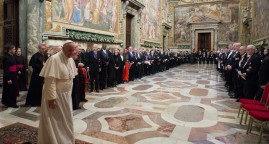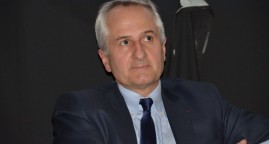Syria’s Monumental Loss
In May 2015, the world watched in horror as ISIS rolled into Tadmur, home to Palmyra’s magnificent Greco-Roman ruins. The ensuing destruction was widely denounced but the extremist group’s first act of vandalism in Palmyra drew condemnations only in Syria. Just a mile northeast of the Temple of Bel (founded 32 AD), stood the Tadmur Prison, one of the Baathist regime’s most notorious. Thousands of political prisoners were incarcerated there, suffering torture, humiliation, starvation, and death. In 1980, up to 1,000 detainees had been summarily executed there as retaliation for an attempt on the then-President Hafez al-Assad’s life. When ISIS blew up this prison, it erased a place of historical importance, a monument to a nation’s agony.
One former inmate of this purgatory was Yassin al-Haj Saleh, arguably Syria’s most important living intellectual, who had been imprisoned in Tadmur for his memberships in a proscribed left-wing party. In his luminous volume of essays The Impossible Revolution: Making Sense of the Syrian Tragedy (Hurst 2017), Saleh writes that the now vanquished revolution helped familiarize Syrians with their own geography as pre-Baathist names of places were restored and hitherto unknown locations assumed a new significance based on their part in the revolution.
But even as the revolution was revealing what Saleh calls the “stifled richness of Syria,” the country’s past was being erased. Shortly after ISIS arrived in Palmyra, the regime launched air strikes on the city, heedless of its ancient monuments. Soon after, ISIS took its own bludgeon to the ruins, destroying the Temple of Bel, the Temple of Baalshamin, and the Monumental Arch.
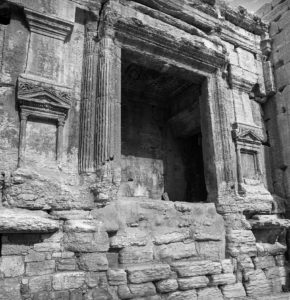
A decade earlier, in 2003, the photographer Kevin Bubriski was in Palmyra, viewing the same sites through his Hasselblad lens. As if anticipating their fate, Bubriski preserved the beauty and grandeur of its various sites—including the Temple of Allat, the Valley of the Tombs, and the Monumental Arch—in exquisite black-and-white photographs that appear together for the first time in Legacy in Stone: Syria Before War. The book is a collection of arresting—and at times, haunting—photographs from three of Syria’s six UNESCO-designated world heritage sites. Five of these, including two captured in this volume, have since been partially or completely destroyed.
The erasure of the past is more than just a material loss, it is also a psychic wound. Totalitarian rule relies on such erasure. It abhors history, which resides in time, and replaces it with myth, which is eternal. Baathists and ISIS have both tried to erase history to create subjects whose submission is absolute, unmoderated by external attachments.
When Bubriski photographed these monuments, they had suffered only the ravages of time. As silent witnesses to two millennia of history, their shapes and textures carried the marks of age. Between human intention and entropic decay, these structures had assumed shapes that endowed them with a mysterious quality. Through his use of perspective, Bubriski accentuates the resilience of these monuments, which appear to stand in defiance of the surrounding desolation.
The photographs of Palmyra inspire the greatest awe. In several of them, natural elements combine with structural artifacts to form preternatural motifs. The doorway to the Temple of Allat appears as if it is communicating in an alphabet of stones, its cryptic logograms materializing from the haze of the desert. The columns and arches of the temples seem to arrange themselves into receding patterns that give ruin a sense of abstract intentionality. The Tower Tomb of Elahbel (since destroyed) exudes a somber air, sitting lonely in the shadow of a distant, illuminated hill.
The few people who appear in these photographs seem conjured from myth: a woman with a handsome face, fair hair, and intense gaze stands in a stony enclosure in a grimy calico dress, her eyes squinting in the mid-day sun; but what gives the photograph its pique is the depth of her tan and the incongruity of her refined features and rough hands. There is the portrait of a Bedouin with searching eyes and tattooed face. There is an old man in a thobe and keffiyeh casually resting with his bicycle before a magnificent Roman colonnade.
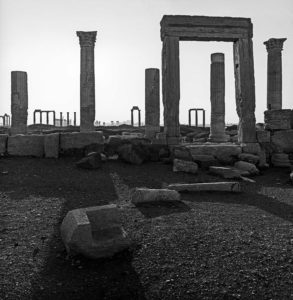
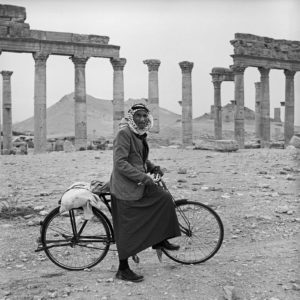



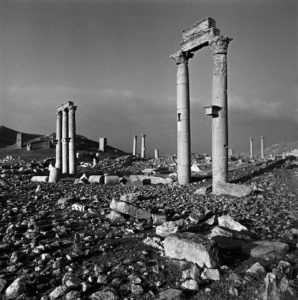
Over a hundred miles to the northwest of Palmyra, on the banks of the Orontes, lies Apamea, whose porticos and arches seem an extension of Palymra’s architectural language. It is home to one of the Roman world’s longest colonnades. The countryside here is greener, the ruins less desolate. To the east, closer to the Euphrates, is Resafe, whose churches are of a sturdier construction, sheltered and homely. More ornate and elegant are the arches and pillars of St. Simeon, north of Aleppo. In the Dead Cities, the elevated countryside between Aleppo and Idlib lie over 600 abandoned settlements dating back to the Byzantine era, where time appears to have frozen with little human intrusion. It is in the souks and the citadel of Aleppo that Syria’s history appears most in harmony with its present. Here, the ancient constructions are more integrated in the city’s daily life.
A magnificent acropolis has crowned the city since the days of Alexander. Bubriski captures the majesty of its imposing citadel in a striking photograph of its fortified gateway, with its steps leading up to a vaulted entrance, surrounded by a stone façade of understated masonry. Beyond its moat and portal, the citadel is a palimpsest on which are inscribed the marks of Hellenic, Roman, Byzantine, Ayyubid, Mongol, Mamluk, and Ottoman cultures. Below the citadel in the old city, Bubriski documents the bustle of the covered souks, with their loitering women in traditional abayas, young seminarians balancing books and shopping, and merchants and artisans plying their trades in its domed alleys. Remove the Suzuki pickup and electric lights and these could be scenes from the nineteenth century—or the fifteenth.
Cities are also vessels of memory. Through colonial rule, wars, and other upheavals, the insularity of such souks and bazaars has helped preserve local cultures against disruptive change. This lends the old city of Aleppo a timeless quality. Thirty-one of Aleppo’s souks, caravanserais, and khans have been severely or entirely destroyed in the regime’s four-year campaign to retake the city. The scenes, recorded by Bubriski in the recent past, now seem remote.
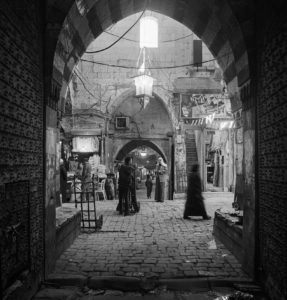
Syrians have suffered grievously in this war. Over half a million killed, over 13 million displaced, all their major cities destroyed. In this general state of precariousness, one expects world heritage to be lower in the hierarchy of its traumatized people’s concerns. Yet, even as their security remains provisional, a civil-society-led effort is underway in Syria’s unvanquished enclaves to preserve what remains of its cultural heritage. As the Syrian archeologist Amr al-Azm notes in his introduction to the book, volunteers in Ma’arrat al-Nu’man have organized to protect and repair the archeological museum that the regime repeatedly bombed in 2015–2016. Al-Azm finds hope in this effort even if its prospects remain uncertain (the regime resumed airstrikes in 2018). In this state of uncertainty, however, Bubriski’s photos may offer a surer record of Syria’s rich heritage.
Photographs can be a form of defiance, an assertion of memory against erasure. If monuments are a projection of the human desire for immortality, these photographs implicitly remind us of the human capacity for destructiveness.
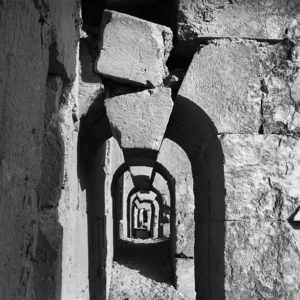
Related Articles
Pope Francis: speech to diplomatic corps
01/11/2016. “The phenomenon of migration raises a serious cultural issue which necessarily demands a response.”
“A final solution is evolving to Eastern Christians”
02/04/2016. Frédéric Pons, professor at the Military School of Saint-Cyr and journalist, update on the situation in Syria, lamenting the blindness of the West.
Pope Francis Received the Grand Master of the Sovereign Order of Malta in Audience
06/23/2016. Pope Francis Received the Grand Master of the Sovereign Order of Malta.


